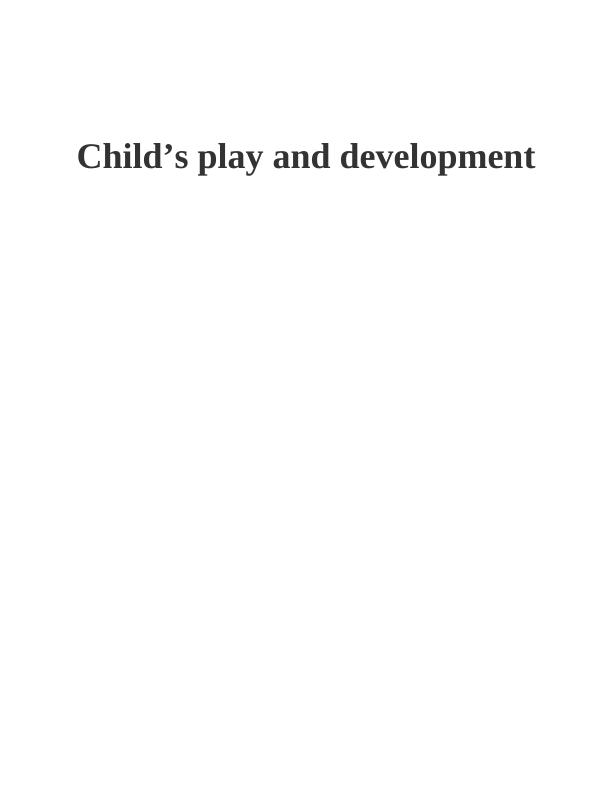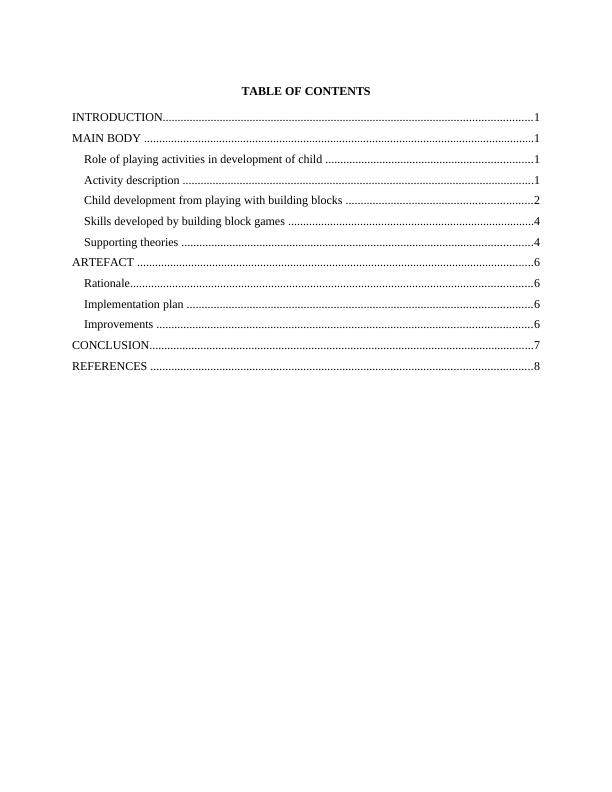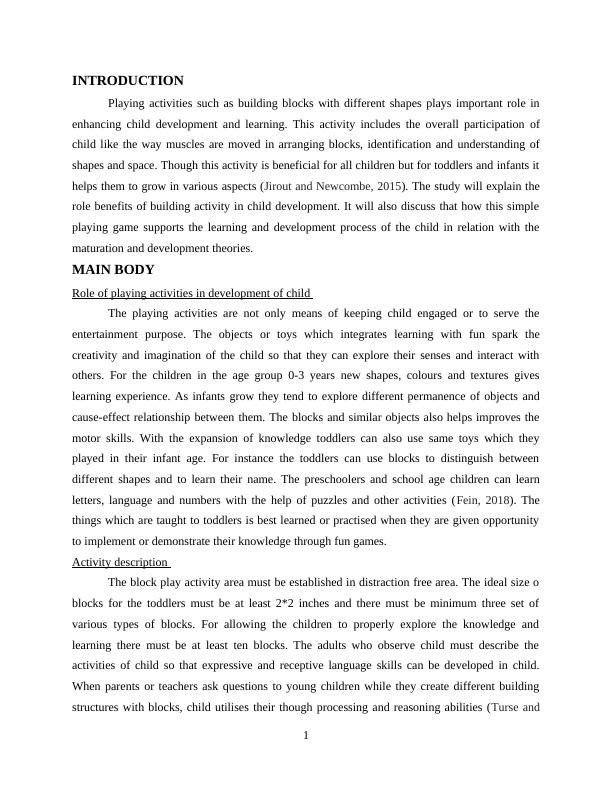Ask a question from expert
Children's Play and Development
15 Pages3035 Words256 Views
Added on 2020-10-22
Children's Play and Development
Added on 2020-10-22
BookmarkShareRelated Documents
Child’s play and development

TABLE OF CONTENTSINTRODUCTION...........................................................................................................................1MAIN BODY ..................................................................................................................................1Role of playing activities in development of child .....................................................................1Activity description .....................................................................................................................1Child development from playing with building blocks ..............................................................2Skills developed by building block games ..................................................................................4Supporting theories .....................................................................................................................4ARTEFACT ....................................................................................................................................6Rationale......................................................................................................................................6Implementation plan ...................................................................................................................6Improvements .............................................................................................................................6CONCLUSION................................................................................................................................7REFERENCES ...............................................................................................................................8

INTRODUCTIONPlaying activities such as building blocks with different shapes plays important role inenhancing child development and learning. This activity includes the overall participation ofchild like the way muscles are moved in arranging blocks, identification and understanding ofshapes and space. Though this activity is beneficial for all children but for toddlers and infants ithelps them to grow in various aspects (Jirout and Newcombe, 2015). The study will explain therole benefits of building activity in child development. It will also discuss that how this simpleplaying game supports the learning and development process of the child in relation with thematuration and development theories. MAIN BODY Role of playing activities in development of child The playing activities are not only means of keeping child engaged or to serve theentertainment purpose. The objects or toys which integrates learning with fun spark thecreativity and imagination of the child so that they can explore their senses and interact withothers. For the children in the age group 0-3 years new shapes, colours and textures giveslearning experience. As infants grow they tend to explore different permanence of objects andcause-effect relationship between them. The blocks and similar objects also helps improves themotor skills. With the expansion of knowledge toddlers can also use same toys which theyplayed in their infant age. For instance the toddlers can use blocks to distinguish betweendifferent shapes and to learn their name. The preschoolers and school age children can learnletters, language and numbers with the help of puzzles and other activities (Fein, 2018). Thethings which are taught to toddlers is best learned or practised when they are given opportunityto implement or demonstrate their knowledge through fun games. Activity description The block play activity area must be established in distraction free area. The ideal size oblocks for the toddlers must be at least 2*2 inches and there must be minimum three set ofvarious types of blocks. For allowing the children to properly explore the knowledge andlearning there must be at least ten blocks. The adults who observe child must describe theactivities of child so that expressive and receptive language skills can be developed in child.When parents or teachers ask questions to young children while they create different buildingstructures with blocks, child utilises their though processing and reasoning abilities (Turse and1

Albrecht, 2015). In the block play game children undergoes into four stages. These stages arecarrying blocks, making roads and piling blocks, connection blocks for creating structures andthen elaborating construction. The teachers or carers must support the child. In the block areathey must communicate and talk with the child that what they are building and what they arethinking. The supervisors must focus on the process through which child is engaging in theprocess instead of final structure developed by the child. For providing the support care takers ofthe child must also comment on the blocks chosen by the child, arrangement pattern or designattribute selected by the child. Block centre must also consist of props so that problem solvingand pattern formation can be improved. In preschools teachers must encourage cooperative playso that rights of every child is protected. Child development from playing with building blocks The block game tends to develop the different aspects of the child by. The block playactivity supports the development of young child in various domains. The key aspects which areimproved and furnished by block play are as follows: Cognitive skills: In order to create new structures toddlers or young children uses creativity andtheir own ideas. They try to utilise their knowledge of mathematical concepts, understanding ofshape, size, area, number, measurement and comparative skills. Thus thinking and analyticalskills of child are developed. The cognitive skills of child to recognise different shapes, coloursand size are also improved by this play activity (Moeller and et.al., 2015). The low socio-economic status can lead slow development of child. Thus, children may have poor cognitiveflexibility. The block activity can enhance the cognitive abilities of the child and thus this mustbe incorporated within all care centres for infants and toddlers. Physical development: The grasping ability, hand manipulation skills and motor skills aregroomed by regular practice of blocks construction. The complex structure in the activitydemands for balance and effective coordination between hands and eyes. Thus, the motor skillsof child are also improved by block building play. Emotional and social skills: While playing the interaction of child with other children makesthem social and teaches that how they can make friends or can work in group (WhatPreschoolers Can Learn From Block Play, 2018). The activity also teachers child to negotiatewith their own ideas or opinion of others. Block activity also teaches child that how they can2

End of preview
Want to access all the pages? Upload your documents or become a member.
Related Documents
Child Study Choosing Development Domainlg...
|22
|5946
|415
Strategies to Enhance Social Interaction Skills of Children During Playtimelg...
|2
|876
|13
CHCECE013 Use Information About Children to Inform Practicelg...
|10
|1328
|112
Curriculum Studies: Teaching Mathematics and EC Numeracy Learning Kitlg...
|25
|3343
|319
Teaching Resources and Learning Experiences for Babies and Toddlerslg...
|5
|1770
|318
Cognitive Development of Infants and Young Childrenlg...
|7
|1368
|371